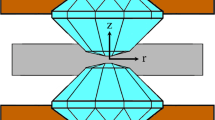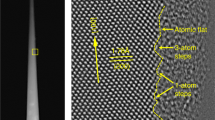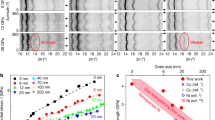Abstract
POLISHED (101) surfaces of type IIB diamonds have been indented with a Knoop indenter at room temperature. The diamonds were thinned from the opposite side by ion-beam bombardment and the resulting deformation observed and analysed using transmission electron microscopy. For the two orientations of indentation examined so far, it has been found that shear events (probably shear cracks) and dislocations comprise the major part of the deformation. Diamond is usually considered to be a brittle material, easy fracture (cleavage) occurring on {111} planes. Although plastic deformation and dislocation generation (also on {111} planes) have been demonstrated in diamond at 1,800 °C (ref. 1) there has been continuing interest as to whether any plastic flow at all occurs at normal temperatures2. Several means of deciding this question have been tried3–7, but the results are mostly inconclusive. We have indented diamond specimens with a Knoop indentor8 and observed the resulting deformation directly using transmission electron microscopy. We report here preliminary results for indentations whose long axes are close to [ 01] and [010] directions in the (101) surface.
01] and [010] directions in the (101) surface.
This is a preview of subscription content, access via your institution
Access options
Subscribe to this journal
Receive 51 print issues and online access
$199.00 per year
only $3.90 per issue
Buy this article
- Purchase on Springer Link
- Instant access to full article PDF
Prices may be subject to local taxes which are calculated during checkout
Similar content being viewed by others
References
Evans, T. & Wild, R. K. Phil. Mag. 12, 479–489 (1965).
Bundy, F. P. Scient. Am. 231, No. 2 62–70 (1974).
Howes, V. R. & Tolansky, S. Proc. R. Soc. A230, 287–301 (1955).
Lawn, B. R. & Komatsu, H. Phil. Mag. 14, 689–699 (1966).
Brookes, C. A. Nature 228, 660–661 (1970); Diamond Research (Suppl. Ind. Diam. Rev.) 12–15 (1971).
Gane, N. Diamond Research (Suppl. Ind. Diam. Rev.) 16–19 (1971).
Wilks, J. Nature 243, 15–18 (1973).
Knoop, F., Peters, C. G. & Emerson, W. B. J. Res. natn. Bur. Stand. 23, 39–61 (1939).
Mazey, D. J., Barnes, R. S. & Howie, A. Phil. Mag. 7, 1861–1870 (1962).
Bilby, B. A. & Eshelby, J. D. Fracture 1, (ed. Liebowitz, H.) 99–182 (Academic, London, 1968).
Head, A. K., Humble, P., Clarebrough, L. M., Morton, A. J. & Forwood, C. T. Computed Electron Micrographs and Defect Identification (North Holland, Amsterdam, 1973).
Hirsch, P. B., Howie, A., Nicholson, R. B., Pashley, D. W. & Whelan, M. J. Electron Microscopy of Thin Crystals 255 (Butterworths, London, 1965).
Author information
Authors and Affiliations
Rights and permissions
About this article
Cite this article
HUMBLE, P., HANNINK, R. Plastic deformation of diamond at room temperature. Nature 273, 37–39 (1978). https://doi.org/10.1038/273037a0
Received:
Accepted:
Issue Date:
DOI: https://doi.org/10.1038/273037a0
This article is cited by
-
Approaching diamond’s theoretical elasticity and strength limits
Nature Communications (2019)
-
Role of plastic deformation in tailoring ultrafine microstructure in nanotwinned diamond for enhanced hardness
Science China Materials (2017)
-
Constitutive Law and Flow Mechanism in Diamond Deformation
Scientific Reports (2012)
-
Role of plastic deformation in the structure formation of ceramic materials
Soviet Powder Metallurgy and Metal Ceramics (1992)
-
Multiple slip in diamond due to a nominal contact pressure of 10 GPa at 1,000 °C
Nature (1988)
Comments
By submitting a comment you agree to abide by our Terms and Community Guidelines. If you find something abusive or that does not comply with our terms or guidelines please flag it as inappropriate.



